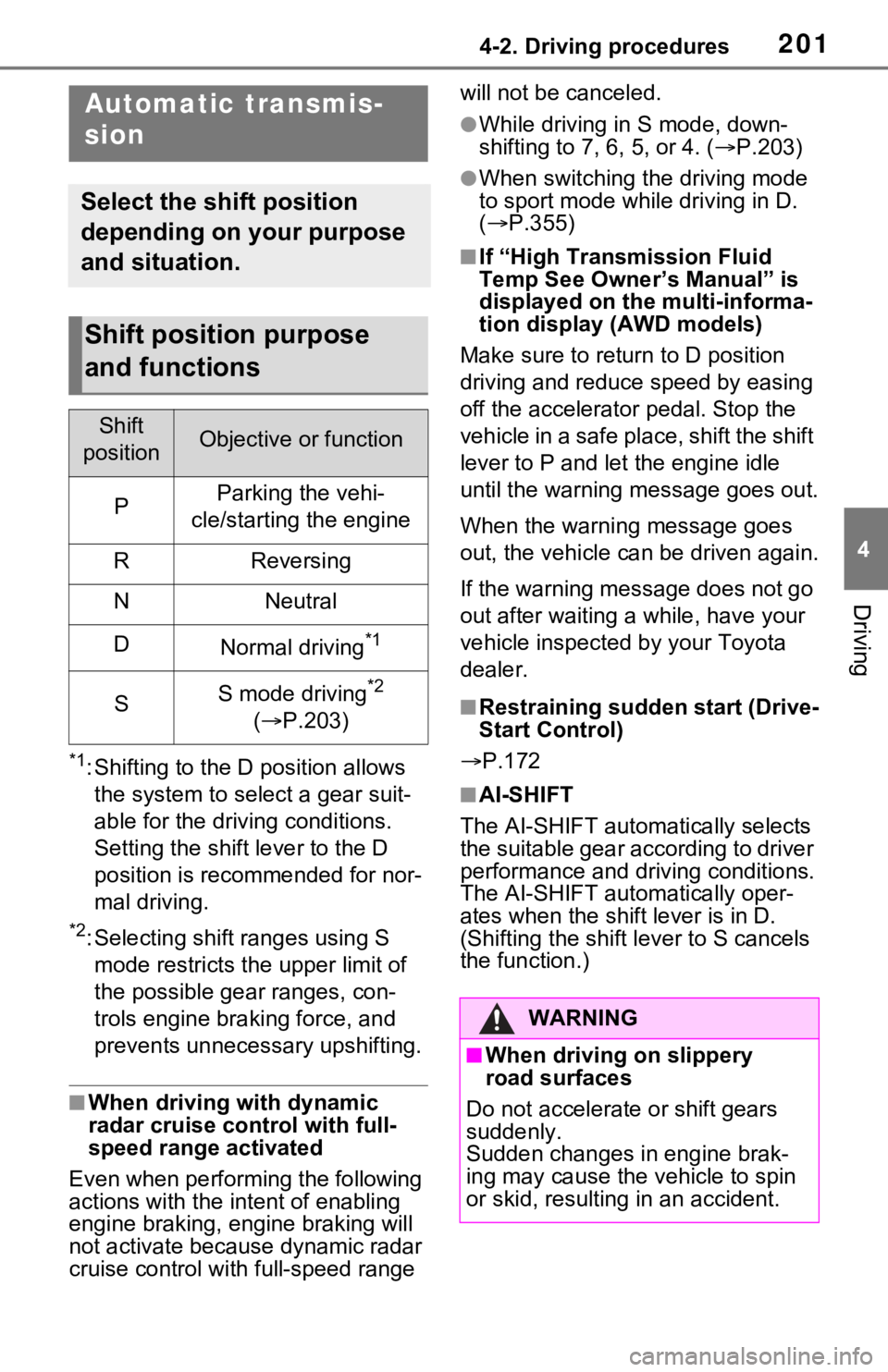manual transmission TOYOTA RAV4 2021 Owners Manual (in English)
[x] Cancel search | Manufacturer: TOYOTA, Model Year: 2021, Model line: RAV4, Model: TOYOTA RAV4 2021Pages: 748, PDF Size: 30.79 MB
Page 192 of 748

1924-1. Before driving
3When the wheel blocks are in
place, release the brakes
slowly until the blocks absorb
the load.
4 Apply the parking brake
firmly.
5 Shift into P and turn off the
engine.
ďŹ When restarting after parking
on a slope:
1 With the transmission in P,
start the engine. Be sure to
keep the brake pedal
depressed.
2 Shift into a forward gear. If
reversing, shift into R.
3 If the parking brake is in man-
ual mode, release the park-
ing brake. (ďŽ P.205)
4 Release the brake pedal, and
slowly pull or back away from
the wheel blocks. Stop and
apply the brakes.
5 Have someone retrieve the
blocks.
â Break-in schedule
If your vehicle is new or equipped
with any new power train compo-
nents (such as an engine, transmis-
sion, differential or wheel bearing),
Toyota recommends that you do not
tow a trailer unt il the vehicle has
been driven for over 500 miles (800
km).
After the vehicle has been driven for
over 500 miles (800 km), you can
start towing. However, for the next
500 miles (800 km), drive the vehi-
cle at a speed of less than 45 mph
(72 km/h) when towing a trailer, and avoid full throttle acceleration.
â Maintenance
âIf you tow a traile
r, your vehicle
will require more fr equent mainte-
nance due to the additional load.
(See âScheduled Maintenance
Guideâ or âOwner âs Manual Sup-
plementâ.)
âRetighten the fixing bolts of the
towing ball and bracket after
approximately 600 miles (1000
km) of tra iler towing.
â If trailer sway occurs
One or more factors (crosswinds,
passing vehicles, rough roads, etc.)
can adversely affect handling of
your vehicle and t railer, causing
instability.
âIf trailer swaying occurs:
⢠Firmly grip the steering wheel. Steer straight ahead.
Do not try to contr ol trailer sway-
ing by turning the steering wheel.
⢠Begin releasing the accelerator
pedal immediately but very gradu-
ally to reduce speed.
Do not increase speed. Do not
apply vehicle brakes.
If you make no extreme correction
with the steering or brakes, your
vehicle and trailer should stabilize (if
enabled, Trailer Sway Control can
also help to stabilize the vehicle and
trailer.).
âAfter the trailer swaying has
stopped:
⢠Stop in a safe place. Get all occu-
pants out of the vehicle.
⢠Check the tires of the vehicle and the trailer.
⢠Check the load in the trailer. Make sure the load has not
shifted.
Make sure the tongue weight is
appropriate, if possible.
⢠Check the load in the vehicle.
Make sure the vehicle is not over-
loaded after occupants get in.
If you cannot find any problems, the
Page 201 of 748

2014-2. Driving procedures
4
Driving
*1: Shifting to the D position allows the system to select a gear suit-
able for the driving conditions.
Setting the shift lever to the D
position is recommended for nor-
mal driving.
*2: Selecting shift ranges using S mode restricts the upper limit of
the possible gear ranges, con-
trols engine brak ing force, and
prevents unnecessary upshifting.
â When driving with dynamic
radar cruise control with full-
speed range activated
Even when performing the following
actions with the in tent of enabling
engine braking, e ngine braking will
not activate because dynamic radar
cruise control with full-speed range will not be canceled.
âWhile driving in S mode, down-
shifting to 7, 6
, 5, or 4. (ďŽP.203)
âWhen switching th e driving mode
to sport mode while driving in D.
( ďŽ P.355)
â If âHigh Transmission Fluid
Temp See Ownerâs Manualâ is
displayed on the multi-informa-
tion display (AWD models)
Make sure to return to D position
driving and reduce speed by easing
off the accelerato r pedal. Stop the
vehicle in a safe place, shift the shift
lever to P and let the engine idle
until the warning message goes out.
When the warning message goes
out, the vehicle can be driven again.
If the warning message does not go
out after waiting a while, have your
vehicle inspected by your Toyota
dealer.
â Restraining sudden start (Drive-
Start Control)
ďŽ P.172
â AI-SHIFT
The AI-SHIFT automa tically selects
the suitable gear according to driver
performance and driving conditions.
The AI-SHIFT automatically oper-
ates when the shift lever is in D.
(Shifting the shift lever to S cancels
the function.)
Automatic transmis-
sion
Select the shift position
depending on your purpose
and situation.
Shift position purpose
and functions
Shift
positionObjective or function
PParking the vehi-
cle/starting the engine
RReversing
NNeutral
DNormal driving*1
SS mode driving*2
( ďŽ P.203)
WARNING
â When driving on slippery
road surfaces
Do not accelerate or shift gears
suddenly.
Sudden changes in engine brak-
ing may cause the vehicle to spin
or skid, resulting in an accident.
Page 351 of 748

3514-5. Using the driving support systems
4
Driving
⢠The vehicle has been driven a cer-tain amount of time.
⢠The brake pedal is being depressed firmly. (except when
the vehicle is stopped by the
dynamic radar cruise control with
full-speed range when in vehicle-
to-vehicle distanc e control mode)
⢠The D shift position is selected.
⢠The driverâs seat belt is fastened.
⢠The driverâs door is closed.
⢠The selected driv ing mode is nor-
mal or Eco drive mode.
⢠The selected driv ing mode is not
snow mode (AWD models).
⢠Mud & Sand or Rock & Dirt mode
is not selected for Multi-terrain
Select (AWD models).
⢠The windshield defogger is off.
(vehicles without a manual air
conditioning system)
⢠The accelerator pedal is not being depressed.
⢠The engine is adequately warmed up.
⢠The outside temperature is 23°F (-
5°C) or higher.
⢠The hood is closed. ( ďŽP.352)
âIn the following situations, the
engine may not be stopped by the
Stop & Start syste m. This is not a
malfunction of the Stop & Start
system.
⢠When the air conditioning system
is being used.
⢠When the battery is undergoing a periodic recharge.
⢠When the battery is not sufficiently charged, such as if the vehicle
has been parked for a long time
and the battery charge has
decreased, the e lectric load is
large, the battery fluid tempera-
ture is excessively low or the bat-
tery has deteriorated.
⢠When the brake booster vacuum
is low.
⢠When the elapsed time since the engine was restarted is short.
⢠When the vehicle is stopped fre- quently, such as when in a traffic
jam.
⢠When the engine coolant tem- perature or transmission fluid tem- perature is extremely low or high.
⢠When the vehicle is stopped on a
steep incline.
⢠When the steering wheel is being
operated.
⢠When the vehicle is being driven in a high altitude area.
⢠When the battery fluid tempera- ture is extremely low or high.
⢠For a while after the battery termi-
nals have been disconnected and
reconnected.
âWhen the engine is stopped by
the Stop & Star t system, the
engine will be restarted automati-
cally if any of the following condi-
tions are met:
(To enable the engine to be
stopped by the Stop & Start sys-
tem again, drive the vehicle.)
⢠The air conditioning system is turned on. (vehicles without a
manual air conditioning system)
⢠The windshield defogger is turned on. (vehicles without a manual air
conditioning system)
⢠The shift lever is shifted from D.
⢠The driverâs seat belt is unfas- tened.
⢠The driverâs door is opened.
⢠The driving mode is changed from normal or Eco drive mode to
another mode.
⢠The driving mode is changed to
snow mode (AWD models).
⢠Mud & Sand or Rock & Dirt mode is selected for Mult i-terrain Select
(AWD models).
⢠The Stop & Start cancel switch is pressed.
⢠The steering wheel is operated.
⢠The accelerator pedal is depressed.
⢠The vehicle starts to roll on an incline.
âWhen the engine is stopped by
the Stop & Star t system, the
engine may restart automatically
in the following situations: (To
enable the engine to be stopped
by the Stop & Start system again,
drive the vehicle.)
⢠When the brake pedal is pumped
Page 376 of 748

3764-6. Driving tips
WARNING
âWhen driving off-road or in rug-
ged terrain, do not drive at
excessive speeds, jump, make
sharp turns, strike objects, etc.
This may cause loss of control
or vehicle rollover causing
death or serious injury. You are
also risking expensive damage
to your vehicleâs suspension
and chassis.
NOTICE
â To prevent the water damage
Take all necessary safety mea-
sures to ensure that water dam-
age to the engine or other
components does not occur.
âWater entering the engine air
intake will cause severe engine
damage.
âWater entering the automatic
transmission will cause deterio-
ration in shift quality, locking up
of your transmission accompa-
nied by vibration, and ultimately
damage.
âWater can wash the grease
from wheel bearings, causing
rusting and premature failure,
and may also enter the differen-
tials, transmission and transfer
case (AWD models), reducing
the gear oilâs lub ricating quali-
ties.
â When you drive through
water
If driving through water, such as
when crossing shallow streams,
first check the depth of the water
and the bottom of the riverbed for
firmness. Drive slowly and avoid
deep water.
â Inspection after off-road driv-
ing
âSand and mud that has accu-
mulated around brake discs
may affect braking efficiency
and may damage brake system
components.
âAlways perform a maintenance
inspection after each day of off-
road driving that has taken you
through rough terrain, sand,
mud, or water. For scheduled
maintenance information, refer
to the âScheduled Maintenance
Guideâ or âOwnerâs Manual
Supplementâ.
Page 650 of 748

6508-2. Steps to take in an emergency
shown while the dr iving support sys-
tems such as PCS (Pre-Collision
system) or the dynamic radar cruise
control with full-speed range is oper-
ating. If a warning message is
shown, be sure to decelerate the
vehicle or follow an instruction
shown on the multi -information dis-
play.
A warning message is shown when
Brake Override Syst em, Drive-Start
Control or Parking Support Brake (if
equipped) ( ďŽP.172, 281) operates.
Follow the instruct ions on the multi-
information display.
âIf a message about an operation
of the engine switch is shown (if
equipped)
An instruction for operation of the
engine switch is shown when the
incorrect procedure for starting the
engine is performed or the engine
switch is operated incorrectly. Fol-
low the instructi ons shown on the
multi-information display to operate
the engine switch again.
âIf a message abou t a shift lever
operation is shown
To prevent the shift lever from being
operated incorrectly or the vehicle
from moving unexpectedly, a mes-
sage that requires shifting the shift
lever may be sho wn on the multi-
information display. In that case, fol-
low the instruction of the message
and shift the shift lever.
âIf a message or image about an
open/close state of a part or
replenishment of a consumable is
shown
Confirm the part indicated by the
multi-information display or a warn-
ing light, and then perform the cop-
ing method such as closing the open door or replenishing a con-
sumable.
â If a message that indicates the
need for visiting your Toyota
dealer is displayed
The system or part shown on the
multi-information di splay is malfunc-
tioning. Have the vehicle inspected
by your Toyota dea ler immediately.
â If a message that indicates the
need for referring to Ownerâs
Manual is displayed
âIf âEngine Coolant Temp Highâ is
shown, follow the instructions
(ďŽ P.670).
âIf the following messages are
shown, there may be a malfunc-
tion.
Immediately stop the vehicle in a
safe place and contact your
Toyota dealer. Continuing to drive
the vehicle may be dangerous.
⢠âCharging System Malfunctionâ
⢠âHigh Transmission Fluid Tempâ
⢠âSmart Key System Malfunctionâ
âIf the following messages are
shown, there may be a malfunc-
tion.
Immediately have the vehicle
inspected by your Toyota dealer.
⢠âOil Pressure Lowâ
⢠âBraking Power Lowâ
â If âShift to P when Parkedâ is
shown (if equipped)
Message is displayed when the
driverâs door is opened without turn-
ing the engine s witch to OFF with
the shift lever in any position other
than P.
Shift the shift lever to P.
â If âAuto Power OFF to Conserve
Batteryâ is shown (if equipped)
Power was turned off due to the
automatic power off function.
Next time when starting the engine,
increase the engine speed slightly
and maintain that level for approxi-
mately 5 minutes t o recharge the